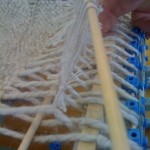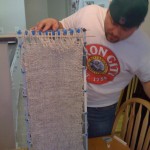Weaving a Quiver
by Steve Struebing on Dec.20, 2008, under technoPHOBE
Why Weave?
So you may rightly be asking yourself “What in this dude’s right mind does he want to have to do with weaving? Doesn’t he have anything better to do?”. A fair question. However, let me take a moment to defend myself. Really the catalyst of all this, and a lot of the technoPhobe content, stems from a random meeting at a bar. I had just finished the longbow project, and was in Wolfboro Tavern in New Hampshire enjoying some drinks with my stepfather. Somehow we got to talking to a guy next to us who was ravenously attacking a plate of wings like he had never eaten before.
“Wifes a vegeterian. She’s out of town, so this is one of the few shots I get unless I am teaching class.” , he says.
Inquisitively I ask “Class?” What do you teach?”
“Primitive survival skills.”, he adds as another defleshed wing bone hits the plate.
Needless to say, I had many other questions for him. We talked about longbows, firebuilding, etc. Before he rolled out for the night, he turned me onto this book “Caveman Chemistry” (author Kevin M. Dunn. A great book I may add now from experience. I have bought 4 copies for friends). There is a chapter on spinning yarn, and hence my desire to be able to spin, and weave, something of purpose. Spinning I will cover later.
The Loom
The first step is to buy (or build from Construx) a loom. Next, you have to “warp the loom”. This is done by running yarn lengthwise on the loom. By alternating direction in a figure 8 type fashion, you can create what is called a “natural shed” against the loom. No need to bore you with details.

Loom built of Construx
As mentioned, warping yarns are the long yarns that run the length of the loom (in our case, this could change depending on the loom). The weft yarns to back and forth.
There are all kinds of interesting patterns that you can make by changing the pattern of which warp yarns you go over and under. Alternating each (over, under, over, under) is called a “linen weave”. (Here in this illustration, + is over the warp, -is under.
+ – + – + – + – + – + – + – + – + – + – + – +
– + – + – + – + – + – + – + – + – + – + – + –
+ – + – + – + – + – + – + – + – + – + – + – +
– + – + – + – + – + – + – + – + – + – + – + –
Another example is the twill weave (under, over, over, under, over, over). Note the diagonal bands taking shape in the twill.
– – + – – + – – + – – + – – + – – + – – + – – +
+ – – + – – + – – + – – + – – + – -+ – – + – – +
– – + – – + – – + – – + – – + – – + – – + – – + –
+ – – + – – + – – + – – + – – + – – + – – + – – +

Here the shed stick is opening the "natural shed"
As a kid, you may have had a loom and used a needle or shuttle to go over and under the warp yarns. Well, obviously a better system existed. Using a device, you can mechanically raise the odd and even warp yarns, and just shoot the shuttle down the gap (known as the shed). The one raising the “natural shed” (the yarns naturally raised by the loom) is called the “shed stick”.

Here the "heddling stick" raises the alternate warp yarns opposite the natural shed.
The implement that raises the alternative warp yarns is called the “heddling stick”. There are also looms (one of which I will no doubt build as I have acquired the wood for it) which achieve the heddling action as a function of the loom itself. This is called a “rigid heddle loom”.

Using a fork in a whipping movement to compress the weft yarn
So by simply alternating raising the natural shed, running the shuttle down, raising the heddling stick, bringing the shuttle back (rinse and repeat), you achieve this linen weave. Each couple of rows we would use a fork to tighten the weave.
Here are some additional shots showing cleverness from my technoPhobe cohort in finishing the seam with a needle, working the leather base, and finishing the product.

Detail of the opened shed

Almost 50%

Finally done. This needs to be automated.

Sewing the seam

Borrowing the innovation of a needle

Finished at last
Note the leather guard at the opening to prevent damage, and the leather base that my friend made very successfully.
Now, all I need are some arrows, and I can live off the land. Provided the land has an XBox 360, and a power supply.


January 26th, 2009 on 1:18 am
There is obviously a lot to know about natural. I think you made some good points in a Quiver – Polymythic